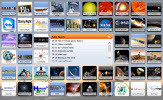September 2018
This month
Click here for the month at a glance calendar.

September 30th Moon 0.5 - 1.0o from Aldebaran
Mercury will be visible over the eastern horizon before sunrise for the first week but will move closer to the Sun each day as Mercury moves eastward. Watch for a close conjunction with the star Regulus in the constellation Leo the Lion on the morning of September 6.
Venus will be visible at sunset over the western horizon but will be lower each evening as it moves westward toward the Sun. Venus will start the month with a close conjunction with the star Spica in the constellation Virgo.
Mars will be over the southeastern horizon at sunset and will nearly reach its maximum apparent magnitude. At the end of the month, Mars will be at heliocentric conjunction with the planet Neptune. Both planets will have approximately the same ecliptic longitude of 345o.
Dwarf Planet Ceres will be very low over the western horizon this month, setting within an hour of sunset and will be too dim to be seen with the unaided eye.
Jupiter Jupiter will be visible over the southwest horizon at sunset and will set about three hours after the Sun..
Saturn will be over the southern horizon at sunset and will sets about six hours later. Saturn will be within the constellation area of Sagittarius and the Milky Way, offering an opportunity for some night sky pictures.












 Above the Solar System at 10 day Intervals
Above the Solar System at 10 day Intervals

 Lee's Summit, MO
Lee's Summit, MO 